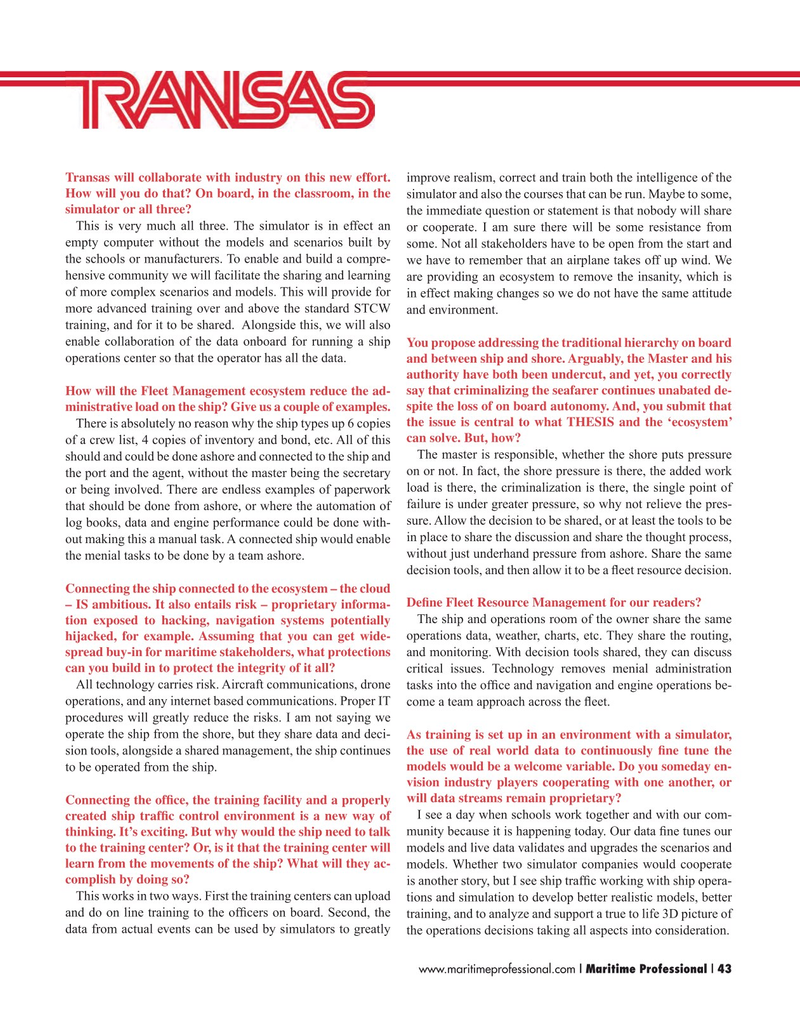
Page 43: of Maritime Logistics Professional Magazine (Q1 2016)
Maritime Training and Education
Read this page in Pdf, Flash or Html5 edition of Q1 2016 Maritime Logistics Professional Magazine
Transas will collaborate with industry on this new effort. improve realism, correct and train both the intelligence of the
How will you do that? On board, in the classroom, in the simulator and also the courses that can be run. Maybe to some, simulator or all three? the immediate question or statement is that nobody will share
This is very much all three. The simulator is in effect an or cooperate. I am sure there will be some resistance from empty computer without the models and scenarios built by some. Not all stakeholders have to be open from the start and the schools or manufacturers. To enable and build a compre- we have to remember that an airplane takes off up wind. We hensive community we will facilitate the sharing and learning are providing an ecosystem to remove the insanity, which is of more complex scenarios and models. This will provide for in effect making changes so we do not have the same attitude more advanced training over and above the standard STCW and environment.
training, and for it to be shared. Alongside this, we will also enable collaboration of the data onboard for running a ship You propose addressing the traditional hierarchy on board operations center so that the operator has all the data. and between ship and shore. Arguably, the Master and his authority have both been undercut, and yet, you correctly
How will the Fleet Management ecosystem reduce the ad- say that criminalizing the seafarer continues unabated de- ministrative load on the ship? Give us a couple of examples. spite the loss of on board autonomy. And, you submit that
There is absolutely no reason why the ship types up 6 copies the issue is central to what THESIS and the ‘ecosystem’ of a crew list, 4 copies of inventory and bond, etc. All of this can solve. But, how?
The master is responsible, whether the shore puts pressure should and could be done ashore and connected to the ship and the port and the agent, without the master being the secretary on or not. In fact, the shore pressure is there, the added work or being involved. There are endless examples of paperwork load is there, the criminalization is there, the single point of that should be done from ashore, or where the automation of failure is under greater pressure, so why not relieve the pres- sure. Allow the decision to be shared, or at least the tools to be log books, data and engine performance could be done with- in place to share the discussion and share the thought process, out making this a manual task. A connected ship would enable without just underhand pressure from ashore. Share the same the menial tasks to be done by a team ashore.
decision tools, and then allow it to be a ? eet resource decision.
Connecting the ship connected to the ecosystem – the cloud
De? ne Fleet Resource Management for our readers?
– IS ambitious. It also entails risk – proprietary informa- tion exposed to hacking, navigation systems potentially The ship and operations room of the owner share the same hijacked, for example. Assuming that you can get wide- operations data, weather, charts, etc. They share the routing, spread buy-in for maritime stakeholders, what protections and monitoring. With decision tools shared, they can discuss can you build in to protect the integrity of it all? critical issues. Technology removes menial administration
All technology carries risk. Aircraft communications, drone tasks into the of? ce and navigation and engine operations be- operations, and any internet based communications. Proper IT come a team approach across the ? eet.
procedures will greatly reduce the risks. I am not saying we operate the ship from the shore, but they share data and deci- As training is set up in an environment with a simulator, sion tools, alongside a shared management, the ship continues the use of real world data to continuously ? ne tune the to be operated from the ship. models would be a welcome variable. Do you someday en- vision industry players cooperating with one another, or
Connecting the of? ce, the training facility and a properly will data streams remain proprietary?
created ship traf? c control environment is a new way of I see a day when schools work together and with our com- thinking. It’s exciting. But why would the ship need to talk munity because it is happening today. Our data ? ne tunes our to the training center? Or, is it that the training center will models and live data validates and upgrades the scenarios and learn from the movements of the ship? What will they ac- models. Whether two simulator companies would cooperate complish by doing so? is another story, but I see ship traf? c working with ship opera-
This works in two ways. First the training centers can upload tions and simulation to develop better realistic models, better and do on line training to the of? cers on board. Second, the training, and to analyze and support a true to life 3D picture of data from actual events can be used by simulators to greatly the operations decisions taking all aspects into consideration.
www.maritimeprofessional.com | Maritime Professional | 43 34-49 Q1 MP2016.indd 43 2/29/2016 11:14:08 AM

 42
42

 44
44
